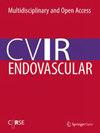Carbon dioxide-enhanced angiography for detection of colonic diverticular bleeding and clinical outcomes
IF 1.2
Q3 CARDIAC & CARDIOVASCULAR SYSTEMS
引用次数: 0
Abstract
To determine the ability of CO2-enhanced angiography to detect active diverticular bleeding that is not detected by iodinated contrast medium (ICM)-enhanced angiography and its impact on clinical outcomes when used to confirm embolization, particularly the risks of rebleeding and ischemic complications. We retrospectively identified a cohort of patients with colonic diverticular bleeding who underwent catheter angiography between August 2008 and May 2023 at our institution. We divided them according to whether they underwent CO2 angiography following a negative ICM angiography study or to confirm hemostasis post-embolization (the CO2 angiography group) or ICM angiography alone in the absence of active bleeding or for confirmation of hemostasis post-embolization (the ICM angiography group). The ability to detect active colonic diverticular bleeding and clinical outcomes were compared between the two groups. There were 31 patients in the ICM angiography group and 29 in the CO2 angiography group. The rate of detection of active bleeding by CO2 angiography that was not identified by ICM angiography was 48%. The rebleeding rate was 23% in the ICM angiography group and 6.9% in the CO2 angiography group. Among the patients who underwent TAE, the ischemic complications rate was 7.1% in the ICM angiography group and 4.5% in the CO2 angiography group. CO2 angiography may detect active diverticular bleeding that is not detectable by ICM angiography and appears to be associated with a lower rebleeding rate. IV.用于检测结肠憩室出血的二氧化碳增强血管造影术及临床结果
目的:确定二氧化碳增强血管造影术检测碘化造影剂 (ICM) 增强血管造影术未检测到的活动性憩室出血的能力,以及二氧化碳增强血管造影术用于确认栓塞时对临床结果的影响,尤其是再出血和缺血性并发症的风险。我们对 2008 年 8 月至 2023 年 5 月期间在我院接受导管血管造影术的结肠憩室出血患者进行了回顾性研究。我们根据他们是在 ICM 血管造影检查阴性后接受 CO2 血管造影检查还是为了确认栓塞后止血(CO2 血管造影检查组),或者是在没有活动性出血或为了确认栓塞后止血而单独接受 ICM 血管造影检查(ICM 血管造影检查组),对他们进行了分类。对两组患者检测活动性结肠憩室出血的能力和临床结果进行了比较。ICM 血管造影组有 31 名患者,CO2 血管造影组有 29 名患者。二氧化碳血管造影术发现的活动性出血率为 48%,而 ICM 血管造影术未发现。ICM 血管造影组的再出血率为 23%,CO2 血管造影组为 6.9%。在接受 TAE 的患者中,ICM 血管造影组的缺血性并发症发生率为 7.1%,CO2 血管造影组为 4.5%。二氧化碳血管造影术可检测到 ICM 血管造影术检测不到的活动性憩室出血,而且似乎与较低的再出血率有关。IV.
本文章由计算机程序翻译,如有差异,请以英文原文为准。
求助全文
约1分钟内获得全文
求助全文
来源期刊

CVIR Endovascular
Medicine-Radiology, Nuclear Medicine and Imaging
CiteScore
2.30
自引率
0.00%
发文量
59
 求助内容:
求助内容: 应助结果提醒方式:
应助结果提醒方式:


